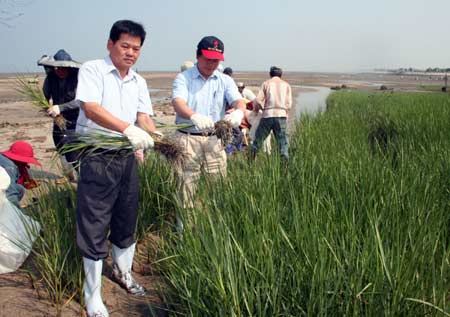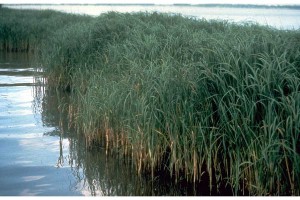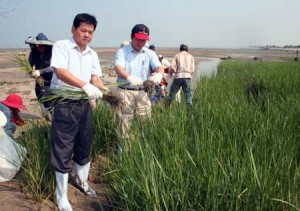November 24, 2013 – A few months ago I read about China’s effort to stabilize the mouth of the Yangtze River to ensure that it can survive storm surges from weather events and rising sea levels. The decision to introduce cordgrass, also known as Spartina, a salt-marsh tolerant plant in 1979, was thought to be the answer. But with no biological control on this plant it has spread to more than 400,000 hectares (almost 1 million acres) all along China’s east coast. And like all invasive species it is overwhelming local biodiversity, threatening coastal nature reserves, coastal fish populations and millions of migratory birds.
Today the cordgrass infestation dominates 10% of China’s coastal wetlands, a fourfold growth in the last 10 years. Most at risk are fish like the Chinese Sturgeon which thrives in shallow wetlands that the cordgrass today has turned into mudflats. And Chinese Sturgeon are not alone. Almost 60 other species of fish are now at risk while birds like the Reed Parrotbill have seen populations decline by 40%.
The Chinese now are in the business of trying to eradicate the noxious weed and near Shanghai have been constructing an 8-meter high, 27-kilometer long sea wall to block the tide from reaching 2,400 hectares of cordgrass-infested coastline. Within the walled off areas the cordgrass is being cut to the ground and then the roots are being submerged in saltwater for six months. This technique in laboratory settings has shown a high propensity to succeed in killing of the plant.
There may be even more unintended consequences from this attempted cure. In creating these walled off areas China may be further interfering with the stability of coastal wetlands and their biodiversity. So from one folly China may beget another.
Of course China is not alone in having introduced animals and plants into new habitats. Australia had an interesting experience with rabbits when they were introduced more than 150 years ago. They are still battling the little bunnies to this day. And the United States has its own experience with kudzu, a highly invasive vine first introduced from East Asia to the Americas at the United States Centennial exhibition in Philadelphia in 1876. It soon became highly fashionable in southern gardens and today has gone rogue overwhelming trees and shrubs, killing off native plants and even causing power outages as it climbs hydroelectric poles. Recently kudzu was found in Southwestern Ontario, that’s how far it has spread in its assault on North America.
Kudzu is North America’s equivalent to cordgrass, a plant from North America that has now infested China. Humans with good intentions and unintended consequences – when will we learn?
Related articles across the web




















